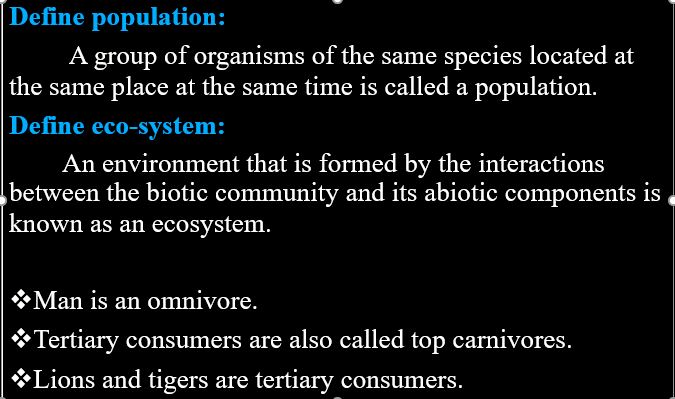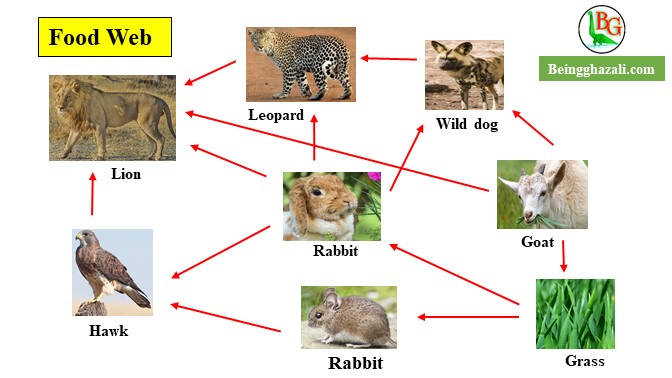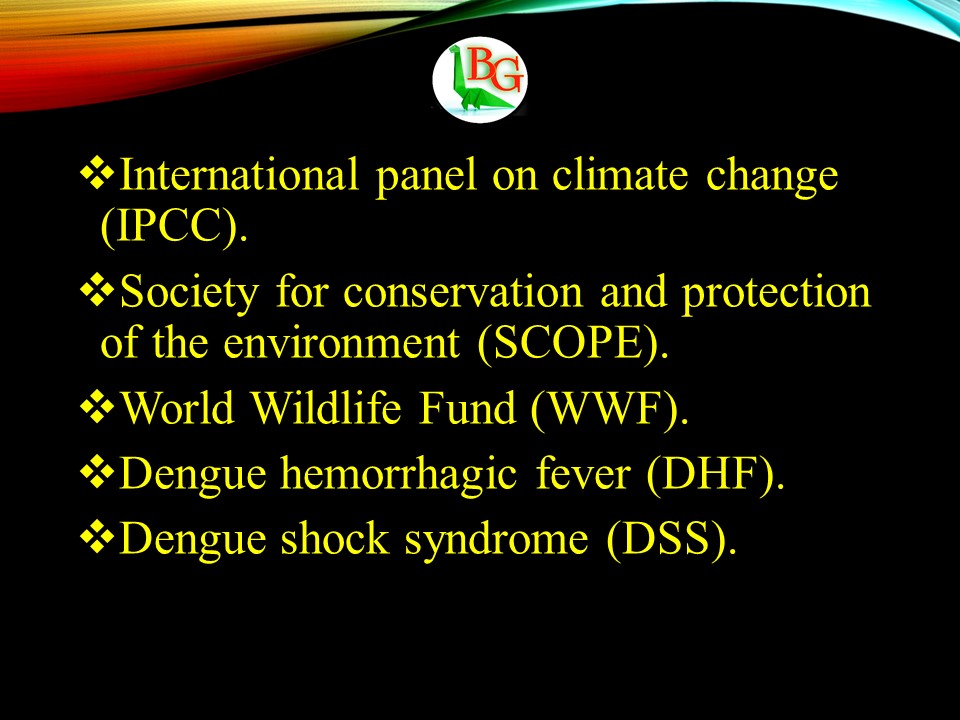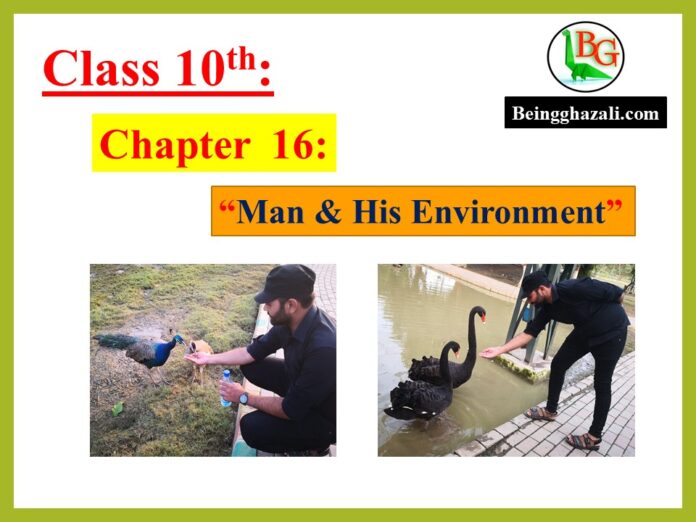10th class biology MCQs and Questions
Chapter -16
“Man and His Environment”
1. The study of the interrelationship between organisms and their environment is called
a) Ecosystem
b) Ecology
c) Physiology
d) Embryology
Sol: (b) Ecology
2. Living factors living in an ecosystem are called
a) Biotic components
b) Abiotic components
c) Both (a) and (b)
d) None of the above
Sol: (a) Biotic components
3. The plants, algae, and photosynthetic bacteria are called
a) Consumers
b) Producers
c) Decomposers
d) Primary consumers
Sol: (b) producers
4. The shallow water-rooted plants are called
a) Consumers
b) Decomposers
c) Producers
d) Phytoplankton
Sol: (d) Phytoplankton
5. The consumers that eat animals and plants as well are called
a) Carnivores
b) Omnivores
c) Herbivores
d) None of the above
Sol: (b) Omnivores

6. The consumers that feed on plants are called
a) Herbivores
b) Carnivores
c) Omnivores
d) Producers
Sol: (a) Herbivores
7. Cattle, deer, rabbits, grasshoppers etc. are examples of
a) Decomposers
b) Carnivores
c) Herbivores
d) Producers
Sol: (c) Herbivores

8. The primary source of energy for all ecosystems is
a) ATP
b) Glucose
c) Carbohydrates
d) Sun
Sol: (d) Sun
9. A network of food chains which are interconnected at various trophic levels are called
a) Food chain
b) Food web
c) Ecological pyramid
d) None of the above
Sol: (b) Food web

10. Who developed the concept of ecological pyramids?
a) Charles Darwin
b) Charles Dickens
c) Charles Babbage
d) Charles Elton
Sol: (d) Charles Elton
11. The total amount of living or organic matter in an ecosystem at any time is called
a) Biomass
b) Biodiversity
c) Bio geosciences
d) Biological method
Sol: (a) Biomass

12. The cyclic pathway through which materials move from the environment to organisms and back to the environment is called
a) Linear Cycle
b) Geochemical cycle
c) Biogeochemical cycles
d) All of the above
Sol: (c) Biogeochemical cycle
13. Carbon found in
a) Peat
b) Coal
c) Petroleum
d) All of the above
Sol: (d) All of the above
14. Carbon occurs naturally in
a) Graphite
b) Diamond
c) None of the above
d) Both (a) and (b)
Sol: (d) both (a) and (b)
15. Conversion of nitrogen gas into nitrates is called
a) Nitrogen fixation
b) Nitrogen peroxide
c) Nitrates
d) Nitrous oxide
Sol: (a) Nitrogen fixation
16. Ammonia is converted into nitrites by which bacteria
a) Nitrobacter
b) Pseudomonas
c) Mycobacterium
d) Nitrosomonas
Sol: (d) Nitrosomonas
17. The intersections between the members of the same species are called
a) Interspecific interactions
b) Intraspecific interactions
c) Homogenous interactions
d) All of the above
Sol: (b) intraspecific interactions
18. The intersections between the members of the different species are called
a) Intraspecific interactions
b) Interspecific interactions
c) Both (a) and (b)
d) None of the above
Sol: (b) Interspecific interactions
19. A group of organisms, which can interbreed in nature and produce fertile offspring is called
a) Genus
b) Population
c) Density
d) Species
Sol: (d) Species
20. Pitcher plant and Venus fly trap are live as
a) Pray
b) Predator
c) Parasitism
d) Mutualism
Sol: (b) Predator

21. The relationship between members of different species and they live together for shorter or longer periods
a) Symbiosis
b) Mutualism
c) Parasitism
d) Commensalism
Sol: (a) Symbiosis
22. The type of symbiosis in which a smaller partner derives food and shelter from the body of a larger partner and in turn, harms it
a) Parasitism
b) Commensalism
c) Mutualism
d) None of the above
Sol: (a) Parasitism
23. Which type of competition is always stronger and more severe
a) Interspecific competition
b) Intraspecific competition
c) Both (a) and (b)
d) None of the above
Sol: (b) Intraspecific competition
24. The type of parasite that live on the surface of host’s body and get food from there is called
a) Ectoparasite
b) Endoparasite
c) Parasite
d) None of the above
Sol: (a) Ectoparasite
25. The tapeworm, Ascaris, Entamoeba, and Plasmodium are the examples of
a) Ectoparasite
b) Endoparasite
c) Mutualism
d) All of the above
Sol: (b) Endoparasite
26. The type of symbiotic interaction in which both partners get benefits and neither is harmed
a) Mutualism
b) Commensalism
c) Parasitism
d) All of the above
Sol: (a) Mutualism
27. The type of symbiosis in which one partner is benefited while the other is neither benefited nor harmed is called
a) Mutualism
b) Parthenogenesis
c) Parasitism
d) Commensalism
Sol: (d) Commensalism
28. Earth’s surface temperature has increased ………….per decade in the past 30 years?
a) 0.1℃
b) 0.2℃
c) 0.3℃
d) 0.6℃
Sol: (b) 0.2℃
29. Acid rain has a pH value
a) 1-2
b) 3-6
c) 4-8
d) 10-12
Sol: (b) 3-6
30. The flow of energy in different trophic levels of the ecosystem is
a) Multidirectional
b) Unidirectional
c) Two directional
d) Directional less
Sol: (b) Unidirectional
31. What type of symbiosis between honeyguide and badger is ?
a) Mutualism
b) Commensalism
c) Parasitism
d) Both (a) and (b)
Sol: (a) Mutualism
32. Any undesirable change in the physical, chemical, or biological characteristics of air, water, and land that may harmfully affect living organisms and natural resources are called
a) Pollution
b) Urbanization
c) Afforestation
d) Eutrophication
Sol: (a) Pollution
33. The substances that cause pollution are called
a) Pollutants
b) Afforestation
c) Ozone depletion
d) None of the above
Sol: (a) Pollutants
34. Enrichment of water or lake with excessive nutrients is called
a) Pollution
b) Eutrophication
c) Urbanization
d) All of the above
Sol: (b) Eutrophication
35. In which year Pakistan developed the National Conservation Strategy?
a) 1947
b) 1967
c) 1999
d) 1992
Sol: (d) 1992

36. Which of the following is the abiotic component of the ecosystem?
a) Producers
b) Herbivores
c) Carnivores
d) Oxygen
Sol: (d) Oxygen
37. When we eat onions, our trophic level is;
a) Decomposer
b) Producers
c) Secondary consumer
d) Primary consumer
Sol; (d) Primary consumer
38. Which form of nitrogen is taken by the producers of the ecosystem?
a) Nitrogen gas
b) Ammonia
c) Nitrites
d) Nitrates
Sol: (d) Nitrates
39. Identify the correctly matched pair:
a) Rainfall-biotic factors in an ecosystem
b) Global warming-formation of fossil fuels
c) Renewable natural resource-air
d) Corn-secondary consumer
Sol: (c) Renewable natural resource-air
40. Organisms in the ecosystem that are responsible for the recycling of plant and animal wastes are
a) Producers
b) Consumers
c) Competitors
d) Decomposers
Sol: (d) Decomposers
41. In the food chain tree → caterpillar → robin → hawk →coyote, which is the secondary consumer?
a) Caterpillar
b) Robin
c) Hawk
d) Coyote
Sol: (b) Robin
42. In ecosystems, the flow of ________ is one way, while______ is/are constantly recycled.
a) Minerals, energy
b) Energy, minerals
c) Oxygen, energy
d) Glucose, water
Sol: (b) Energy, minerals
43. In the food chain “grass → rabbit → fox → bear → mushroom” , how many types of decomposers are present?
a) 1
b) 2
c) 3
d) 4
Sol: (a) 1
Important definitions that are asked in previous boards of Pakistan.
Define community
Define ecosystem
Define biosphere
Define food chain
Define mutualism
Define commensalism
Define global warming
Define greenhouse effect
Define deforestation
Define urbanization
Important Questions in this chapter that are asked in previous boards of Pakistan
Difference between community and population
Difference between biotic and abiotic components?
Explain food web with examples.
Explain the carbon cycle with a labeled diagram.
Explain the nitrogen cycle with its steps and diagram.
Difference between pray and predator.
Difference between mutualism and commensalism with examples.
Write the effects of acid rain.
Write the effects of air population
Explain eutrophication.
Write the plans for the conservation of nature
Class 9th Biology Class 10th Biology
Introduction to Biology Gaseous exchange
Solving a biological problem Pharmacology
Biodiversity Homeostasis
Class 10th biology chapter 16 “Man and its environment” MCQs and Questions.



Nice
Thanks G
ye website bna kr ap logo sy acha km kya !!! jo academy afford nhi kr skty wo yha se apni study continoun rk sty hn!!! i pround of u guys !!!
best of luck with best wishes !!!
thnks for today !!!
Thanks sir.
ye website bna kr ap logo ny acha km kya !!! jo academy afford nhi kr skty wo yha se apni study continoun rk sty hn!!! i pround of u guys !!!
best of luck with best wishes !!!
thnks for today !!!
Thanks for your feedback and kind words. Be happy and work hard.